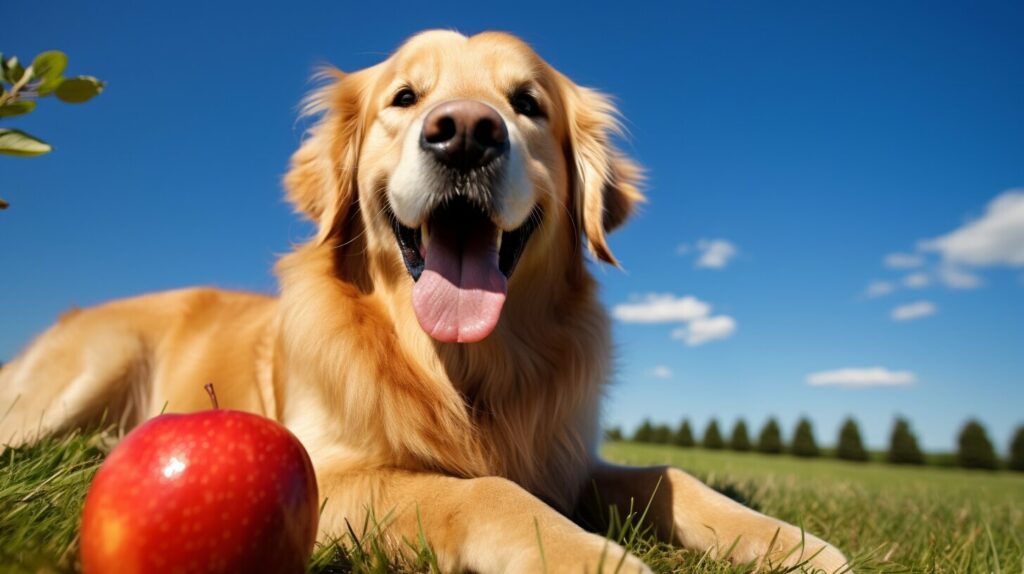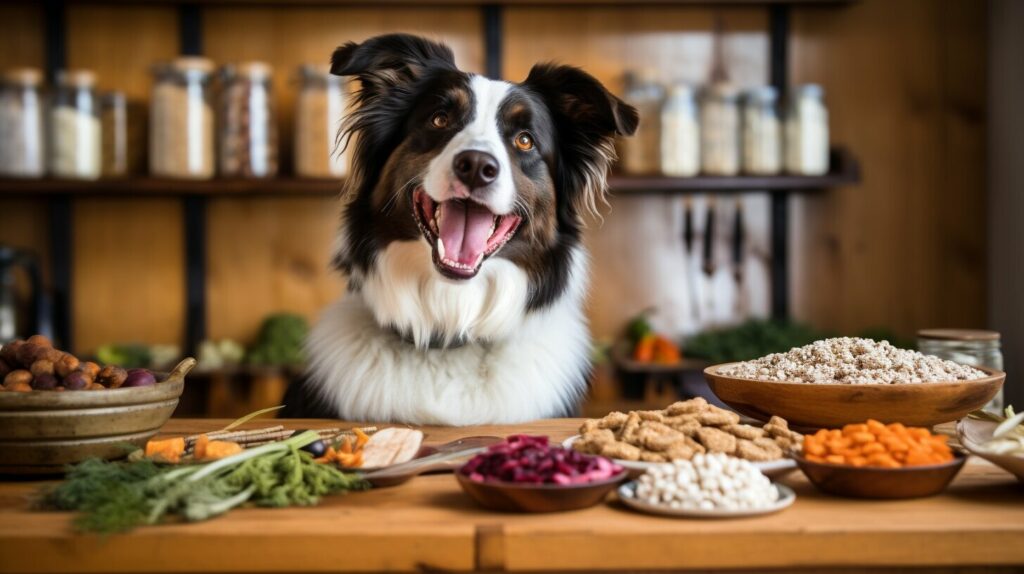As a pet owner, you may be wondering whether it’s safe to share your favorite fruit with your furry friend. Apples are a popular choice for snacking, but can dogs eat apple too?
In this section, we will explore whether dogs can safely consume apples and provide essential information for pet owners. We’ll also discuss the potential health benefits that apples can offer to dogs, guidelines on how to prepare and serve apples to dogs, recommended portion sizes, and potential risks.
Key Takeaways:
- Apples are generally safe for dogs to eat but should be given in moderation.
- Apples provide fiber, vitamins A and C, and antioxidants that can benefit your dog’s health.
- When feeding apples to your dog, remove the core, seeds, and stem, as they can be harmful to dogs.
- Introduce apples to your dog’s diet gradually and monitor their response.
- Consult with your veterinarian for specific dietary advice.
Benefits of Feeding Dogs Apple
If you’re looking to add a healthy and tasty snack to your dog’s diet, apples are a great option. Not only are they low in calories, but they also provide a variety of potential health benefits for your furry friend.
Rich in Nutrients
Apples are a great source of nutrients that can contribute to your dog’s overall health. They contain fiber, vitamin C, vitamin A, and potassium, which can help support healthy digestion, immune function, and even heart health.
Promotes Dental Health
Chewing on apples can help clean your dog’s teeth by removing plaque and freshening their breath. The fibrous texture of apples also promotes healthy gums and can reduce the risk of dental issues such as gingivitis.
May Reduce Cancer Risk
Apples contain various antioxidants, such as quercetin, which may help reduce the risk of cancer in humans. While there is limited research on the effect of apples on canine cancer risk, it is believed that these antioxidants may also offer similar benefits to our furry friends.
Helps with Weight Management
Apples are low in calories and high in fiber, which can help your dog feel full for longer periods of time. This can aid in weight management by reducing the risk of overeating and promoting a healthy weight.
While feeding your dog apples can offer numerous benefits, it is important to also be aware of the potential risks and to consult with your veterinarian before introducing any new food to your pet’s diet.
How to Safely Feed Dogs Apple
While apples can be a healthy addition to your dog’s diet, it is important to prepare and serve them safely. Follow these guidelines to ensure your furry friend’s safety and enjoyment:
- Wash the apple thoroughly: Before feeding your dog an apple, make sure to wash it well to remove any dirt, pesticides, or waxes. This will prevent your dog from ingesting any harmful chemicals or substances.
- Remove the core and seeds: The core and seeds of an apple can pose a choking hazard to dogs and contain small amounts of cyanide, which can be toxic if ingested in large quantities. Always remove the core and seeds before feeding your dog apple slices.
- Cut the apple into small slices: To make it easier for your dog to eat and digest, cut the apple into small, bite-sized pieces that are appropriate for their size. Large apple slices can be a choking hazard or cause intestinal blockages.
- Feed in moderation: Like any treat or new food, it is important to feed apples to your dog in moderation. Too much apple can cause gastrointestinal upset, such as diarrhea or stomach pain. The recommended serving size is no more than 1-2 slices per day, depending on your dog’s size and weight.
- Watch for signs of an allergic reaction: Some dogs may be allergic to apples, just like humans. Watch for any signs of an allergic reaction, such as itching, swelling, or difficulty breathing, and consult with your veterinarian if you suspect an allergy.
By following these simple steps, you can safely introduce apples into your dog’s diet and provide them with a tasty and healthy snack. If you have any concerns or questions about feeding apples to your dog, consult with your veterinarian for specific advice.
Apple Varieties Safe for Dogs
Not all apples are created equal when it comes to feeding your dog. Some varieties may contain potentially harmful chemicals or seeds that can cause digestive issues or choking hazards. Here are some apple varieties that are safe for your furry friend to consume:
| Apple Variety | Description |
|---|---|
| Granny Smith | This tart apple is a good source of fiber and vitamins A and C. |
| Gala | This sweet apple is low in acid and high in fiber, making it easy for dogs to digest. |
| Honeycrisp | This juicy apple is high in antioxidants and vitamins A and C, providing health benefits to your dog. |
| Golden Delicious | This mild and sweet apple is packed with vitamins and low in fat, making it a healthy snack for your dog. |
As a general rule, avoid feeding your dog any apple seeds, as they contain trace amounts of cyanide, which can be harmful in large quantities. Also, remove the apple core and stem before feeding it to your dog to prevent choking hazards.
Apple Recipes for Dogs
If you’re looking to add some variety to your dog’s diet while still keeping it healthy, there are many apple recipes you can try. Apples are a versatile ingredient that can be used in many ways, from treats to meals.
Apple and Peanut Butter Treats
For a simple yet delicious treat, try combining sliced apples with a spoonful of peanut butter. This protein-packed snack is sure to be a hit with your furry friend.
| Ingredients: | Instructions: |
|---|---|
| – 1 apple – 1 tablespoon creamy peanut butter |
1. Slice the apple into small, bite-sized pieces. 2. Spoon the peanut butter onto the apple slices. 3. Serve and watch your dog enjoy! |
Apple and Chicken Bowl
If you’re looking for a more substantial meal for your dog, try this apple and chicken bowl recipe. It’s packed with protein and nutrients, and your dog will love the flavors.
| Ingredients: | Instructions: |
|---|---|
| – 1 chicken breast – 1 apple, diced – 1/2 cup cooked brown rice – 1 tablespoon olive oil – 1 tablespoon chopped parsley |
1. Cook the chicken breast and chop it into small pieces. 2. In a separate pan, heat the olive oil over medium heat. 3. Add the diced apple and cook until soft. 4. Add the cooked chicken and brown rice to the pan with the apple. 5. Stir well, then add the chopped parsley. 6. Let the mixture cool, then serve to your dog in a bowl. |
When making apple recipes for your dog, remember to always remove the core and seeds before serving. These parts of the apple contain small amounts of cyanide, which can be toxic to dogs in large quantities.
Apple vs. Other Fruits for Dogs
Apples are not the only fruit that dogs can enjoy. While they offer numerous health benefits, it’s important to provide a varied diet that includes other fruits.
Some fruits that are safe for dogs to consume include:
- Bananas
- Blueberries
- Cantaloupe
- Strawberries
- Watermelon
Each fruit contains different vitamins and minerals that can help support your dog’s overall health. For example, bananas are a good source of potassium, while blueberries are high in antioxidants.
When introducing new fruits into your dog’s diet, start with small amounts and monitor their reaction. Some fruits, such as grapes, can be toxic to dogs and should be avoided.
Consulting with your veterinarian can help you determine which fruits are best for your dog’s specific needs and dietary requirements.
Potential Risks of Feeding Dogs Apple
If you’re considering adding apples to your dog’s diet, it’s essential to be aware of some potential risks that come with feeding them this fruit.
Choking Hazard: Always remember to remove the seeds, stems, and core of the apple before feeding it to your dog as they pose choking hazards to your furry friend. Be sure to cut the apple into smaller pieces to avoid the risk of choking.
Upset Stomach: While apples are generally safe for dogs, some may experience an upset stomach or diarrhea if they consume too much fruit or eat it too quickly.
High in Sugar: Apples are high in sugar, which is not ideal for overweight or diabetic dogs. Before feeding your dog apples, consult with your vet about portions and servings, especially if you’re concerned with how much sugar they’re consuming.
To minimize risks, it’s essential to incorporate apples into your dog’s diet slowly and in moderation, ensuring it doesn’t interfere with their health and well-being. If your dog experiences any severe symptoms like constipation, vomiting, or diarrhea, consult your veterinarian.
Recommended Serving Size of Apple for Dogs
When considering adding apples to your dog’s diet, it is important to pay attention to the serving size. While apples can provide numerous health benefits to dogs, too much can lead to digestive upset and weight gain. The recommended serving size of apple for dogs is based on their size and weight.
| Dog Size | Serving Size |
|---|---|
| Small (up to 10 lbs) | 1-2 slices or 1-2 tablespoons of diced apple |
| Medium (11-50 lbs) | 3-4 slices or 2-3 tablespoons of diced apple |
| Large (51-100 lbs) | 5-6 slices or 4-5 tablespoons of diced apple |
| Extra-Large (over 100 lbs) | 7-8 slices or 6-7 tablespoons of diced apple |
It is important to note that the serving sizes above should be used as a guideline only, and may need to be adjusted based on your individual dog’s needs and health status. Always consult with your veterinarian before making any changes to your dog’s diet.
Apple Dog Treats
If you want to treat your furry friend with some sweet and healthy snacks, apple dog treats can be a great option. These treats are made with fresh and preservative-free apples, ensuring a nutritious and tasty addition to your dog’s diet.
When choosing apple dog treats, make sure to read the label carefully and look for natural and high-quality ingredients. Avoid treats that contain added sugars, artificial coloring, or preservatives as they can be harmful to your dog’s health.
You can also make your own apple dog treats at home using simple ingredients such as oatmeal, peanut butter, and cinnamon. There are many recipes available online that you can try based on your dog’s preferences and dietary needs.
Remember to introduce apple treats gradually into your dog’s diet and monitor their response to ensure they are tolerating them well. Also, keep in mind that treats should only make up a small portion of your dog’s overall diet, and they should not replace regular meals.
Overall, apple dog treats can be a great way to show your furry friend some love while providing them with essential vitamins and minerals. So, go ahead and spoil your dog with some delicious and healthy apple treats!
Introducing Apples to Your Dog’s Diet
Now that you know that dogs can eat apples and the potential benefits, it’s time to introduce them to your furry friend’s diet.
It’s important to start gradually, offering a small amount of apple to your dog and monitoring their reaction. If your dog appears to enjoy the apple and has no adverse reactions, you can slowly increase the amount over time.
Remember to always wash and core the apple before feeding it to your dog, and never give them the seeds or stem, which contain a small amount of cyanide and can be harmful to their health.
If your dog has any medical conditions or dietary restrictions, it’s best to consult with a veterinarian before introducing any new foods into their diet, including apples.
Overall, incorporating moderate amounts of apple into your dog’s diet can provide them with a tasty and healthy snack option.
Tips for Choosing and Storing Apples
If you want to feed your furry friend some apple, it’s essential to choose the right ones and store them properly. Here are some tips to help you:
Choosing Apples for Dogs
When selecting apples for your dog, opt for organic ones if possible as they are free from harmful pesticides. You should also choose fresh apples that are firm and free from bruises or soft spots. Additionally, make sure to remove any stems, seeds, and cores of the apple as they can pose a choking hazard to your dog.
Storing Apples for Dogs
Store apples in the refrigerator to maintain their freshness and nutritional value. You can leave them at room temperature for a few days, but they will start to lose their flavor and crispiness. Avoid storing apples near ethylene-producing fruits like bananas as they can speed up the ripening process. Finally, always wash apples thoroughly with clean water before feeding them to your dog.
Conclusion
Congratulations, you now have a comprehensive understanding of whether dogs can eat apples and how to safely incorporate them into their diet.
Remember that while apples can provide numerous health benefits for dogs, they should not replace a balanced diet and consultation with a veterinarian is always recommended before making any significant dietary changes.
When introducing apples to your dog, start with small portions and monitor their response. Always remove the core and seeds, as they pose a choking hazard and can be toxic to dogs.
Further Considerations
If you have any concerns about your dog’s health or diet, it is crucial to speak with a veterinarian for personalized advice. Additionally, keep in mind that not all fruits are safe for dogs, and some may even be toxic. Always research and consult with a professional before adding any new foods to your dog’s diet.
By following the guidelines discussed in this article, you can safely incorporate apples into your dog’s diet and provide them with a tasty and nutritious treat. Remember to store apples properly to maintain their freshness and nutritional value, and consider commercially available apple treats for added convenience.
Thank you for reading, and we hope this guide has been helpful in answering your questions about feeding apples to dogs.
FAQ
Q: Can dogs safely eat apples?
A: Yes, dogs can safely eat apples in moderation. Apples provide essential vitamins and fiber that can benefit their health.
Q: What are the benefits of feeding dogs apples?
A: Feeding dogs apples can provide them with vitamins and fiber, promote good digestion, and support overall canine health.
Q: How should I safely feed apples to my dog?
A: Ensure that you remove the apple core and seeds before serving it to your dog. You can slice or chop the apple into small, manageable pieces.
Q: Which apple varieties are safe for dogs?
A: Popular apple varieties such as Granny Smith or Golden Delicious are safe for dogs to consume.
Q: Are there any apple recipes for dogs?
A: Yes, there are various apple recipes for dogs. You can find tasty and healthy options to add variety to your dog’s diet.
Q: How do apples compare to other fruits for dogs?
A: Apples offer nutritional value and potential benefits for dogs, similar to other fruits commonly fed to them.
Q: Are there any potential risks of feeding dogs apples?
A: Feeding apples to dogs may pose risks such as choking hazards or digestive issues, so it’s important to monitor their consumption.
Q: What is the recommended serving size of apple for dogs?
A: The serving size of apples for dogs should be appropriate for their size and weight to maintain a balanced diet.
Q: Are there commercially available apple dog treats?
A: Yes, there are commercially available apple dog treats that provide a convenient and safe option for incorporating apples into your dog’s diet.
Q: How can I introduce apples to my dog’s diet?
A: You can introduce apples to your dog’s diet gradually, starting with small portions and monitoring their response for any adverse reactions.
Q: What are some tips for choosing and storing apples for dogs?
A: When selecting apples for your dog, choose fresh and firm ones. Properly store them to maintain their freshness and nutritional value.



